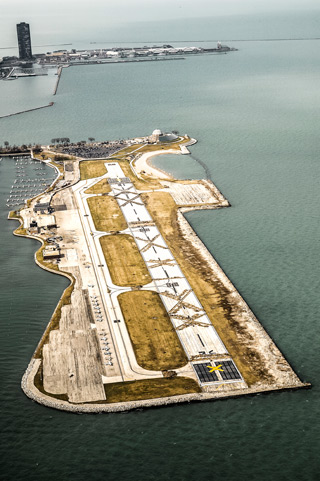
Photography by Mike Fizer
For pilots and aviation enthusiasts the world over, the word “Meigs” conjures memories of a stinging defeat. The late-night sneak attack that destroyed an aviation gem on the Chicago waterfront is full of intrigue, predawn skullduggery, and dirty politics.
On March 31, 2003, at 1:30 a.m. then-Chicago Mayor Richard M. Daley had city work crews tear up the runway at Meigs Field. Using bulldozers, the construction crews dug X-shaped trenches in the asphalt, stranding 16 transient aircraft on the field. There was no warning of the action and a city source said then that the action was taken for “homeland security,” playing on the fears unleashed by the terrorist attacks of September 2001.
 The shuttered former terminal building, temporary concert pavilion, and a seldom-used bike path replaced what was once an aviation gem on Chicago’s waterfront. “Reopen Meigs? Nope,” said current Mayor Rahm Emanuel in a recent interview reported by jetWhine.com.
The shuttered former terminal building, temporary concert pavilion, and a seldom-used bike path replaced what was once an aviation gem on Chicago’s waterfront. “Reopen Meigs? Nope,” said current Mayor Rahm Emanuel in a recent interview reported by jetWhine.com.
Today, the storied former airport—site of the 1933 World’s Fair—is a nearly empty park with a little-used waterfront bike path and a temporary concert venue. The airport terminal building still stands, although it is deteriorating. The observation deck’s balcony is closed for structural reasons. Recently, the Army Corps of Engineers agreed to pay for most of a $6 million project featuring a fish pond on the southern portion of the island. But most of the 91 acres (created by landfill in Lake Michigan) is simply vacant. On a recent January day, the wind howled across the emptiness.
For AOPA, the nation’s advocate for protecting airports and supporting GA, Meigs was a hard-fought battle and major rallying point for members. “None of us like to focus on our losses,” said AOPA Vice President Melissa Rudinger. “But we did not give up on Meigs—even when the Xs were on the runway. We did not go down without a fight, but Meigs was unique; most airports are not like Meigs.”
AOPA had fought against the closure of Meigs since 1994 when Daley began his campaign against the airport. Although it has never been clear why Daley was so against the airport—rumors that he wanted to base a gambling boat from Northerly Island and his wife’s anger over airport noise sometimes were cited—he wanted it closed. And in 1996 when the city’s grant assurances to the FAA expired, he had it closed for the first time (see “What’s a Grant Assurance?” page 64). AOPA took Chicago to court, sought the city residents’ support, created a major PR campaign, and enlisted the aid of members of Congress. The association lobbied the Illinois legislature for a law allowing the state to take over and operate Meigs. The “Meigs Act” was passed that December, allowing a five-year reprieve for Meigs and giving its supporters time to demonstrate the importance of the airport.
 “For years, AOPA had emphasized the rate at which small airports were disappearing from the U.S. landscape. Meigs Field was—in some ways—the prototypical example of the phenomenon,” says Steve Whitney, past and current president of Friends of Meigs Field. “And because it served such a high-value market (commercial flights, business aviation, search and rescue, as well as smaller GA aircraft), it was almost incomprehensible that it could be slated to close.” In mid-1995, the Friends of Meigs Field group was formed and published The Case for Meigs Field. AOPA helped pay to distribute it to the Chicago City Council.
“For years, AOPA had emphasized the rate at which small airports were disappearing from the U.S. landscape. Meigs Field was—in some ways—the prototypical example of the phenomenon,” says Steve Whitney, past and current president of Friends of Meigs Field. “And because it served such a high-value market (commercial flights, business aviation, search and rescue, as well as smaller GA aircraft), it was almost incomprehensible that it could be slated to close.” In mid-1995, the Friends of Meigs Field group was formed and published The Case for Meigs Field. AOPA helped pay to distribute it to the Chicago City Council.
The group discovered that Meigs Field was—in an odd but important way—the ‘home’ airport to aviation enthusiasts around the world. The creators of Microsoft Flight Simulator used Meigs as the default airport. When you fired up MSFS, the first thing you saw was the Chicago skyline, viewed from Runway 36. “This notoriety helped turn what was originally a small group of local aviators and enthusiasts to a worldwide organization, with members on five continents, and in all 435 U.S. congressional districts,” recalls Whitney.
For five years, AOPA and the Friends of Meigs kept up the pressure and although there were times it appeared that the airport would be saved—a U.S. House bill in early 2002 nearly assured its status for 25 years but was blocked by a filibuster in the Senate—Daley was not deterred. His quest to destroy Meigs never wavered.
“We concentrated on promoting and holding events at the airport, but without serious effort in the political or legislative arena,” said Whitney. “What we hadn’t counted on was the near-obsession Daley had with closing Meigs. Even though opinion polls in the city showed widespread support for the airport, Mayor Daley was bent on closing it. He hoped to turn it into green space, and even put his wife in charge of the commission to design the new park. He never agreed to meet with our organization, but all reports—including from many of the city’s top business and civic leaders—indicated that he was unswayable on the issue.”
And so, the early morning destruction took place—a Chicago fire truck blocked the web camera that could have recorded the crime by blinding it with a spotlight. Again, AOPA went to work against the Daley machine. In May, then-AOPA President Phil Boyer proposed a buyout plan, calling for the park district, the current owner of the land, to sell Meigs to the city of Chicago for $41 million. As operator and sponsor of Meigs, the city could then apply for a grant to purchase Meigs through the FAA’s Airport Improvement Program (AIP). The influx of capital would allow the park district to use part of Northerly Island, where Meigs is located, to create a new park and improve others. 
Traditionally, the federal share of aviation projects approved and funded by AIP is 90 percent, which would cover approximately $36.9 million of the appraised value, Boyer said. “It would be necessary to acquire the balance of about $4.1 million from other sources, which could include State of Illinois funding through the state’s aviation program or a special legislative allocation,” he said. Obtaining AIP funding would require the airport remain in operation for 20 years. But support from the city legislature wasn’t there and eventually—despite all of its work and ingenuity—without support in Chicago, AOPA could only go so far. Daley insisted Chicagoans wanted that park. There was nothing AOPA could do.
“Some have criticized AOPA for that,” Boyer then said. “But I approved the action after weighing the pros and cons. It was time to end the financial bleeding. To continue…would have wasted AOPA members’ dollars in a futile action. As a pilot or a manager, you have to recognize when the elements are against you and you need to abandon the approach or risk wrecking the aircraft.”
Victories from Meigs do exist, such as the Meigs legacy amendment in which Congress raised the fine for illegal airport closures. The city paid the FAA $33,000 in fines for closing the airport without notice and had to pay back $1 million in misappropriated FAA AIP funds—funds the city used to destroy the airport. The AOPA Airport Support Network was established in 1997 as a result of the need for local, on-site help; its volunteers are the eyes and ears of the association (see “ASN Names 2,500th Volunteer”); and a strengthened AOPA advocacy staff protects GA throughout the country with a seven-person regional manager program.
“I am gratified to have seen a variety of changes that have happened in the aviation community in the wake of the Meigs effort,” says Whitney. “Ultimately, I think Meigs is a beacon of hope—you can make a difference; getting involved isn’t futile. If the other side hadn’t cheated, I think we would have
succeeded against all odds.”
Email [email protected].
What’s a Grant Assurance?
Why some airports are protected and some are not
According to the FAA, “when airport owners or sponsors, planning agencies, or other organizations that own or control an airport accept funds from the FAA-administered airport financial assistance programs, they must agree to certain obligations (or assurances). These obligations require the recipients to maintain and operate the facilities safely and efficiently—and in accordance with specified conditions. The assurances may be attached to the application or the grant for federal assistance and become part of the final grant offer or in restrictive covenants or property deeds. The duration of these obligations depends on the type of recipient, the useful life of the facility being developed, and other conditions stipulated in the assurances.” In other words, if an airport owner—be it a private individual, city, or other entity—accepts funds from the FAA, they are federally obligated to run the airport as applied for, for the set period of time agreed upon. At Meigs, the city strategically allowed the grant assurances to expire and accepted no new FAA improvement funds so that it could close the airport without FAA interference.
The Top 10
Airports AOPA is most concerned about
Fernandina Beach Municipal Airport (FHB), Fernandina Beach, Florida. Increased residential development in this tourist area pits commercial growth against the airport.
General Mitchell International Airport (MKE), Milwaukee, Wisconsin. GA hangars are under pressure from proposed Air Force expansion.
Hilton Head Airport (HXD), Hilton Head Island, South Carolina. Opponents of the airport do not want improvements, which include runway extension for increased jet traffic.
Norwalk-Huron County Airport (5A1), Norwalk, Ohio. County commissioners want to close the airport for a speedway.
Portland-Hillsboro Airport (HIO), Portland, Oregon. An environmentalist not-so-local neighbor consistently complains about airport noise.
Reno/Tahoe International Airport (RNO), Reno, Nevada. GA access to the international airport may be compromised by the removal of hangars.
Santa Monica Municipal Airport (SMO), Santa Monica, California. Residential neighbors want this historic airport closed because they fear pollution and potential accidents.
St. Clair Regional Airport (K39), St. Clair, Missouri. City officials want to close the airport for retail development.
Tehachapi Municipal Airport (TSP), Tehachapi, California. The city wants approval for a hotel in the airport safety zone.
Van Nuys Airport (VNY), Van Nuys, California. Redevelopment would displace GA hangars.
ASN names 2,500th volunteer
The eyes and ears of the association
AOPA has recruited its 2,500th Airport Support Network volunteer—an important milestone in the association’s effort to help protect every public-use airport in the United States. On January 18, 2013, North Carolina’s Lattie Honeycutt at Rutherford County’s Marchman Field agreed to join AOPA’s fight to save the nation’s airports.
AOPA launched the ASN to identify an AOPA member at each public-use airport in the country who would be willing to serve as the organization’s eyes and ears regarding threats to the airport. The program was immediately successful, with ASN volunteers providing critical information at threatened airports across the nation. These timely updates helped AOPA staff intervene with information to airport sponsors about the value of the airport, the airport’s grant obligations if it had received federal or state funds, and guidance on best practices for land use or airport management that would keep the airport free of operational restrictions.
AOPA has a long history of fighting to save the country’s public-use airports from closure, but a lack of timely information is a serious impediment to effective airport advocacy. Too often, local pilots would call the association for help just as the local government was meeting that evening, or in the next few days, to discuss closing the airport. AOPA realized that receiving information early on and partnering with local pilots would be more effective. Engaging local members in the fight is vital to a positive outcome. Local politicians are much more likely to respond to the concerns of their constituents. Providing a series of “how-to” guides on everything from airport open houses and understanding planning and zoning, to talking to the media, AOPA equips its ASN volunteers and other airport supporters with the tools they need to become effective advocates for their airports.
Marchman Field, where Honeycutt volunteers, is publicly owned and available for public use, with 32 based aircraft and about 33,000 annual general aviation operations. In many ways it’s typical of the GA airports across the country that AOPA works hard to protect, and now, it has a big advantage: it has Lattie Honeycutt watching its back.



